THE REAL JAPAN
A SPECIAL MAGAZINE BY Nikkei Asia
CHANGING FOR THE BETTER Japan’s vital role in tackling the climate crisis
RENEWABLES
FOR
CHANGE
Welcome to issue six of Unlock the Real Japan , a special collaboration between Nikkei Inc. and Time Out Tokyo created to help business leaders gain new insight into one of the most exciting countries on Earth.

4In Unlock you’ll find Nikkei Asia’s renowned insight into the business world combined with Time Out Tokyo’s knowledge of city living, ensuring that visiting executives can experience all sides of life in Japan.
This issue could be our most important to date as we look at the role Japan is taking in tackling the global climate crisis. With the COP27 conference in Sharm El Sheikh on the horizon, we’ve profiled the Japanese businesses and initiatives looking to take the lead in reducing emissions.
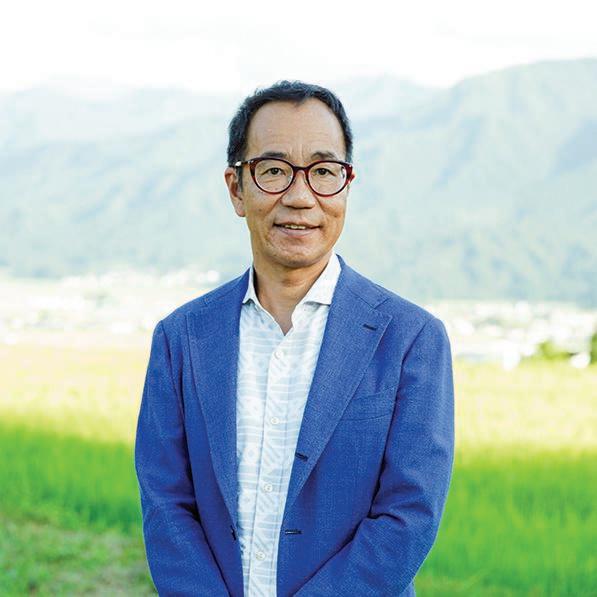
Inside you’ll find the Japanese innovations heading to Egypt (p6), discover the role shipping can play in bringing down greenhouse gas emissions (p12) and meet the government minister playing a vital role in Japan’s efforts to reduce emissions (p4).

We hope you enjoy the issue.
Planned, produced and distributed by Nikkei Inc. Global Business


Edited by Matthew Lee (Time Out Tokyo) Rob Orchard (Time Out Tokyo) Marcus Webb (Time Out Tokyo)
Designed by James Ladbury
Coordinated by Karolina Höglind (Time Out Tokyo/ORIGINAL Inc.)
Ili Saarinen (Time Out Tokyo/ORIGINAL Inc.)
Tabea Greuner (Time Out Tokyo/ORIGINAL Inc.)
Directed by Akiko Toya (Time Out Tokyo/ORIGINAL Inc.)
Nikkei Inc. 1-3-7 Otemachi, Chiyoda-ku, Tokyo 100-8066 +81 (0)3 3270 0251| nikkei.com
Advertising and general enquiries: NARadvertising@nikkei.co.jp
CONTENTS
All rights reserved. Using the content for commercial purpose, citing, reproducing, editing, summarizing or translating the contents without prior permission of Nikkei Inc. is strictly prohibited. NASA KEISUKE TANIGAWA | YOTARO SASAKI | JAMES LADBURY
A
SPECIAL MAGAZINE BY N ikkei Asia 4 HOW TO SAVE THE PLANET The Vice-Minister for Global Environmental Affairs interviewed 6 INSPIRATION NATION The Japanese environmental innovations heading to COP27 8 DOABLE
Kazuya Kitamura on how Japan can meet its emissions targets 10 A POWER
GOOD Can renewables reenergize the city of Kuji? 12 SEA
Toshiaki Tanaka on how shipping can clean up its act 13 OUT OF THE WOODS Department store Shibuya Marui’s sustainable rebirth 14 MAKING WAVES Mitsui O.S.K. Lines’ plans for a carbon-neutral future 16 FREAK OF NATURE A clothing chain’s surprise move into renewable energy production 18 A CLEAN BREAK Sustainable tourism company Jiyujin plans for a new kind of travel 20 IT’S ONLY NATURAL The transformative effects of organic farming 22 ETIQUETTE GUIDE How to travel to and around Japan safely and respectfully 22 6 18 20 A SPECIAL MAGAZINE BY Nikkei Asia | 3
Step one: Make fossil fuels a thing of the past
“In October 2020 Japan declared its aim to become carbon neutral by 2050, and in April 2021 the government committed to reducing greenhouse gas emissions by 46 percent by 2030 compared to 2013 levels. Furthermore, Japan will continue strenuous efforts in its challenge to meet the lofty goal of cutting its emissions by 50 percent. To make those goals a reality, in October 2021 we revised the Strategic Energy Plan, which sets the direction of the country’s energy policy. The plan positions renewable energy as the country’s main source of power and renewables are given the highest priority. Furthermore, in July 2022, the GX (Green Transformation) Implementation Conference led by Prime Minister Kishida was set up to examine the measures necessary to shift from a fossil fuel-oriented economic, social, and industrial structure to one focused on clean energy, thereby reforming the entire economic and social system.”
Step two: Create a healthy, green economy
“In PM Kishida’s statement, carrying out the green transformation is one of the most important pillars in the foundation of a new kind of capitalism. By attracting public and private investment, we want to turn the medium- to long-term challenge of decarbonization into a growth engine for our country and create a sustainable economy. Climate change is the most prominent example of the negative aspects of conventional capitalism, where economic development and environmental destruction exist side by side. A new capitalism, on the other hand, could turn climate change action into a driving force for growth.”
Step three: Work across borders
“Climate change can’t be solved by any one country, and acceleration of emission reductions around the world will certainly be a major theme at COP27. Japan will emphasize its efforts in international cooperation, including but not limited to working together with other Asian countries on the transition to decarbonization, strengthening partnerships to encourage investment in developing countries, and promoting
HOW TO SAVE the planet
Hiroshi Ono, Vice-Minister for Global Environmental Affairs at the Ministry of the Environment, unveils the government’s plans for an inclusive and sustainable economy to energy journalist Kiminori Hiromachi and emphasizes the importance of COP27, the UN climate change conference to be held in Sharm El Sheikh, Egypt in November 2022, to combating climate change
cooperative innovation in the clean energy sector together with developed countries. To aid cooperation with Asian countries, PM Kishida announced the concept of the Asia Zero Emissions Community at the World Economic Forum (in Davos, Switzerland) in January 2022.
This initiative, which has attracted strong interest, is a framework for decarbonizing the Asian region as a whole through mutual cooperation based on a common philosophy of realizing both decarbonization and economic growth in line with the region’s potential. It also aims to create a mechanism for joint international investment and joint funding, including the establishment of Asian rules for climate transition financing.”
Step four: Help developing countries decarbonize
“Japan is also actively involved in establishing a partnership on capacity building for utilizing market mechanisms, which is set to be launched at COP27.
The partnership will enhance the usage of greenhouse gas emission reductions, as removals achieved in one country can be used to meet the national reduction targets of other countries by taking into account
the contributions of the country to achieving [those] reductions and removals. For example, if a Japanese company builds a solar power plant in a developing country and achieves emission reductions, part of those reductions can be counted as Japan’s emission reduction efforts, based on the contribution by the company. This will incentivize Japanese stakeholders to realize such projects, while developing countries will find it easier to introduce decarbonization technologies. Generally speaking, many advanced decarbonization technologies are unlikely to provide a
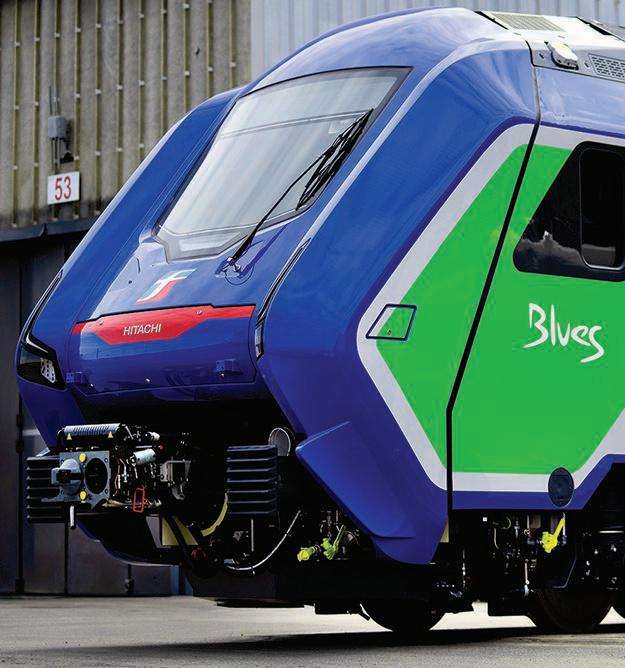
4 | UNLOCK THE REAL JAPAN POLICY
l Ono believes technology like Hitachi’s hydrogen train will bring down emissions
©︎HITACHI RAIL
l Hiroshi Ono, Vice-Minister for Global Environmental Affairs

return on investment in a short period of time, but by making full use of this partnership, it is possible to have developing countries benefit from such technologies without being overburdened financially. It’s a true win-win mechanism.”
Step five: Encourage ground-level actions
“While national-level efforts are the main topic of discussion at the COP, it’s essential that national and local efforts are coordinated in order to achieve national emission reduction targets and ultimately decarbonization. We are committed to supporting local initiatives on decarbonization that capitalize on the specific characteristics of each region. We will be highlighting places that are taking particularly noteworthy steps toward decarbonization in order to quickly generate successful examples of local initiatives not only in large cities, but also in rural locales such as fishing villages, mountainous areas, and remote islands.
At least 100 ‘decarbonization leading areas’ will be selected by 2025 based on the plans submitted by local governments, with the aim of developing these places into model regions through financial and other means of support.”
Step six: Disseminate and share our successes
“Around 40 seminars will be held at the COP27 Japan Pavilion to introduce Japan’s initiatives. The Japan Pavilion will also showcase products and solutions from Japanese companies on climate change mitigation, adaptation, and CO2 utilization. There’ll be ten real-world exhibits, along with 20 virtual exhibits that can be viewed online from anywhere in the world. Our exhibition will cover, for example, a system that generates electricity from solar modules integrated into buildings’ outer walls and windows, hydrogenpowered hybrid railway vehicles, and technologies to utilize recovered CO2 to produce concrete. These are all innovative solutions that will accelerate decarbonization efforts, and we hope that they’ll be instructive for all countries seeking to tackle global warming.”
Step seven: Work both on the short and the long term

“The effects of global warming are manifesting themselves in various destructive forms, such as storms and droughts. In order to meet the
target shared by the international community—‘achieving a balance between anthropogenic emissions by sources [greenhouse gases emitted by human activity] and removals by sinks of greenhouse gases [decarbonizing the atmosphere through CO2 removal techniques such as reforestation] in the second half of this century’—it’s crucial to work toward this goal by 2030. Japan will accelerate its decarbonization efforts through GX, which is integrated with economic growth. Japan will also deploy its diverse technologies, knowledge, and experience around the world to support the efforts of other countries. Furthermore, we will steadily implement our commitment of around US$70 billion in financial support over the next five years and the doubling of financial support for adaptation measures, which we announced at the previous COP.”
“The present turmoil and price spikes in international energy markets related to Russia’s aggression in Ukraine have led to an urgent need for all countries to rebuild stable energy supplies. In the short term, overcoming this crisis is our top priority, but we must not waver with regard to our medium- and long-term goals targeting 2030 and 2050.
“We need to both reverse the crisis at hand and come up with a scenario that will lead to the realization of the GX, which we will then share with the world.
Japan will hold the presidency of the G7 in 2023. Based on the results of COP27, we will deepen discussions and show leadership in overcoming climate change and the energy crisis together with [fellow] G7 members.”
Nikkei
A SPECIAL MAGAZINE BY
Asia | 5
l The Taisei Corporation’s solar power innovations will be on display at the Japan Pavilion at COP27
KISA TOYOSHIMA
Representatives of the world’s governments, along with tens of thousands of other delegates, NGO observers, and members of the media, will be descending on the Egyptian town of Sharm El Sheikh in November for the 27th UN Climate Change Conference. Better known as COP27, the conference will be the latest in a long line of global gatherings aimed at addressing the climate crisis, and attendees are under pressure to put forward and agree on meaningful measures for saving our warming planet.
But the COP is more than a place for negotiating emission reductions. The mega-conference offers an opportunity for countries, companies, and other organizations to showcase their technological and policy achievements in everything from energy production to emissions-free vehicles. It’s an environmental trade show like no other, where many governments set up World’s Fair-style pavilions complete with exhibitions and event programs.
Japan has long counted among the most proactive COP participants and will also have a visible presence in Sharm El Sheikh. The COP27 Japan Pavilion will feature Japanese companies’ products and solutions related to climate change mitigation, adaptation, and CO2 utilization, along with a series of seminars. Visitors will be able to view ten on-site exhibits, which will be complemented by 20 online displays accessible from anywhere in the world. These are some of the groundbreaking technologies set to be exhibited at the Japan Pavilion.
Spacecool
Developed by a Tokyo-based company of the same name, Spacecool is a film-like material that uses radiative cooling technology to mitigate heat
INSPIRATION nation
Unlock previews the world-changing innovations that will be on show at Japan’s pavilion at the upcoming COP27 conference

without the use of electricity, achieving a cooling effect of up to six degrees Celsius. The interiors of buildings and vehicles coated with Spacecool can be expected to stay comfortably crisp even at the height of summer, and the material can also be used on containers such as propane cylinders and gas storage tanks to prevent their contents from overheating. In the future, shorts, T-shirts, and parasols may well feature a layer of Spacecool, too.
T-eConcrete/Carbon-Recycle
Unlike regular concrete that’s a mixture of cement, sand, and water, T-eConcrete/Carbon-Recycle uses calcium carbonate—a material produced by combining calcium with CO2 captured from exhaust gases—as its main ingredient. Manufacturing T-eConcrete absorbs more CO2 from the atmosphere than the amount emitted during the process, making the Taisei Corporation’s invention a carbon-negative product.
Plastic Into Gas and Hydrogen Engineering company JGC Holdings Co. has devised a process for converting waste plastics into a synthetic gas that can be used in the manufacture of chemical products such as methanol, ammonia, and propylene. The same method also allows for the production of hydrogen, making it both a promising solution for the reduction of plastic waste and a potential path toward a cleaner energy system.
Hydrogen Hybrid Train
Hitachi’s train of the future runs on fuel cells and electricity stored in onboard batteries. The fuel cells generate electricity when the hydrogen in them reacts with oxygen in the air. This electricity is then stored in the batteries, which also recharge when the train brakes. An optimally efficient mix of hydrogen power and electricity is supplied to the train’s hybrid engine at all times, minimizing energy use.
6 | UNLOCK THE REAL JAPAN TECHNOLOGY
l An artist’s impression of Japan’s COP27 pavilion






DOABLE renewables
Japan has set itself ambitious renewable energy targets for the year 2030, but can they be achieved? The head of the Japan Renewable Energy Link (J-REL), Kazuya Kitamura, talks to Io Kawauchi about what needs to happen

Some say that Japan’s finest hour on the global environmental stage came in 1997, when the Kyoto Protocol was adopted at a UN climate change conference held in the ancient capital. This was an international treaty that saw countries across the world pledging to reduce their greenhouse gas emissions.
But where do Japan’s climate efforts stand 25 years later? Kazuya Kitamura, energy journalist and head of the Japan Renewable Energy Link (J-REL), a consultancy working to promote renewable energy, gives a harsh assessment. “The Kyoto Protocol was progressive, but unfortunately no serious action has been taken to combat global warming since then,” he says. “Compared to much of the rest of the world, Japan has had a weak sense of urgency with regard to global warming, and its policy-making process is always playing catch-up with more environmentally advanced countries.”
However, a number of initiatives have been introduced after a government declaration in 2020 that renewables would make up 36–38 percent of the country’s total energy production by 2030, roughly doubling the ratio of 2019. In May of this year, the government’s interim report concerning its clean energy strategy estimated that in order to achieve this goal, the public and private sectors would need to invest some ¥150 trillion over the next decade.
Kitamura points out that for Japan to achieve carbon neutrality in the future,
the way energy is produced and consumed needs to change radically. One such shift is towards the production of energy from hydrogen, which emits no carbon dioxide when burned.
“Hydrogen has been considered costly,” Kitamura says, “but in recent years, prices have fallen to a competitive level. Green hydrogen, which can be stored by electrolyzing water with surplus renewable energy, can be effective for decarbonization purposes. And Japan has a long history of hydrogen research, with the Hitachi Zosen Corporation and Kobelco Eco-Solutions, a subsidiary of Kobe-based steel manufacturer Kobelco, having the most advanced technology.”
Plans are underway in the European Union, adds Kitamura, to bring in renewable energy in excess of demand, and use it to create green hydrogen.
Widespread adoption would mean that hydrogen energy has potential as an industry.
Another European trend is the popularization of heat pumps, which collect heat from the air to use as energy. Heat pump units are highly rated for their energy-saving capabilities, and the market for these devices in Europe has been growing at an average annual rate of more than ten percent over the past decade. Japanese manufacturer Daikin Industries is one of the global leaders in the field.
In terms of consumption, Kitamura highlights the sharing of energy by using electric vehicles (EVs) as storage batteries. REXEV, a start-up involved in EV-based car sharing and energy management, initiated an EV-sharing scheme in the western part of Kanagawa Prefecture, including the city of Odawara, in 2020. The vehicles are charged with renewable energy through Shonan Power Co, which provides locally-produced renewable electricity for nearby consumption.
Another Japanese tech start-up setting its sights on EVs is Yanekara, the developer of a system that can charge and power multiple vehicles simultaneously using solar energy. Yanekara has conducted tests to curb electricity peaks by remotely monitoring and controlling the charging of EVs used by Japan Post for collection and delivery.
“The key point is how to use EVs as movable storage batteries, and I think there’s a lot of room for various applications,” says Kitamura. “EVs can also be incorporated into business continuity plans as electricity sources in the event of a disaster, so using them as storage batteries is likely to become more common in the future.”
Through the technological advances of large corporations on the production side, and the innovations of start-ups impacting consumption, Japan’s ambitious decarbonization goals can hopefully be achieved.
8 | UNLOCK THE REAL JAPAN GREEN ENERGY
KEISUKE TANIGAWA
Green hydrogen can be effective for decarbonization... and Japan has a long history of hydrogen research


To many, the small city of Kuji, located on the coast of Iwate Prefecture, is best known as the setting for Amachan, a phenomenally popular TV drama first screened nearly a decade ago. It followed the story of Aki Amano, a high school student from Tokyo who moves to the city and ends up becoming a pop star. The show was credited with boosting tourism and bringing economic benefits to Kuji, a city of just 30,000, which had suffered damage from the tsunami caused by the 2011 Great East Japan Earthquake.
Now Kuji is back in the spotlight with a new energy initiative that could also have a lasting impact. Locally produced energy, consumed locally, is being eyed as a way to promote renewables, contributing not only to decarbonization but to the recovery of the local economy, as utility expenses and other costs will be paid to local businesses. At the heart of these efforts is Kuji Regional Energy, established in 2018 to produce power from renewable sources in the city. The enterprise is jointly financed by the city of Kuji and several private companies headquartered in the municipality, led by the local construction firm Miyagi Kensetsu. Among the roughly 70 power companies in Japan set up by municipalities, Kuji Regional Energy is one of the few to be entirely owned and managed by local stakeholders.
Power to the people
Concern for the local community was the driving force behind the company’s founding. The population of Kuji was already in decline before the 2011 disaster, and the local government has been struggling to prevent the outflow of talent and money since. “We want to do something to stop the decline,” says Haruo Wakabayashi, CEO of Kuji Regional Energy. “We’re not thinking about profit.”
Kuji Regional Energy sells electricity to public facilities, private companies and households within the city. While expanding its customer base, the company is seeking to procure power from more renewable energy plants in the region. In one high-profile effort, it has teamed up with the Iwate Prefectural Enterprise Bureau, which operates one of the country’s largest hydroelectric power plants, to procure electricity from the Taki Dam in Kuji. Electricity generated from the dam is currently used to power cultural facilities such as the city’s Amber Hall.
A POWER for good
The idea seems simple—local energy for local consumption. Kazuya Kitamura discovers how the production of renewables is revitalizing the city of Kuji
The company is also developing new renewable energy sources—including photovoltaic power stations, which convert light into electricity—by collaborating with the Bank of Iwate. Despite the fact that rising electricity costs are putting a squeeze on the business, Kuji Regional Energy donates a part of its profits to the city to help support its citizens with issues such as childcare.
Another key contributor to Kuji’s decarbonization efforts is the Kuji Biomass Energy Corporation, one of the largest renewable heat suppliers in Japan, which combines the supply of heat with mushroom farming.
Working closely with Kuji Regional Energy, the company uses locally discarded bark as fuel, cultivating shiitake mushrooms in 60 large greenhouses, and supplies woodchips dried using
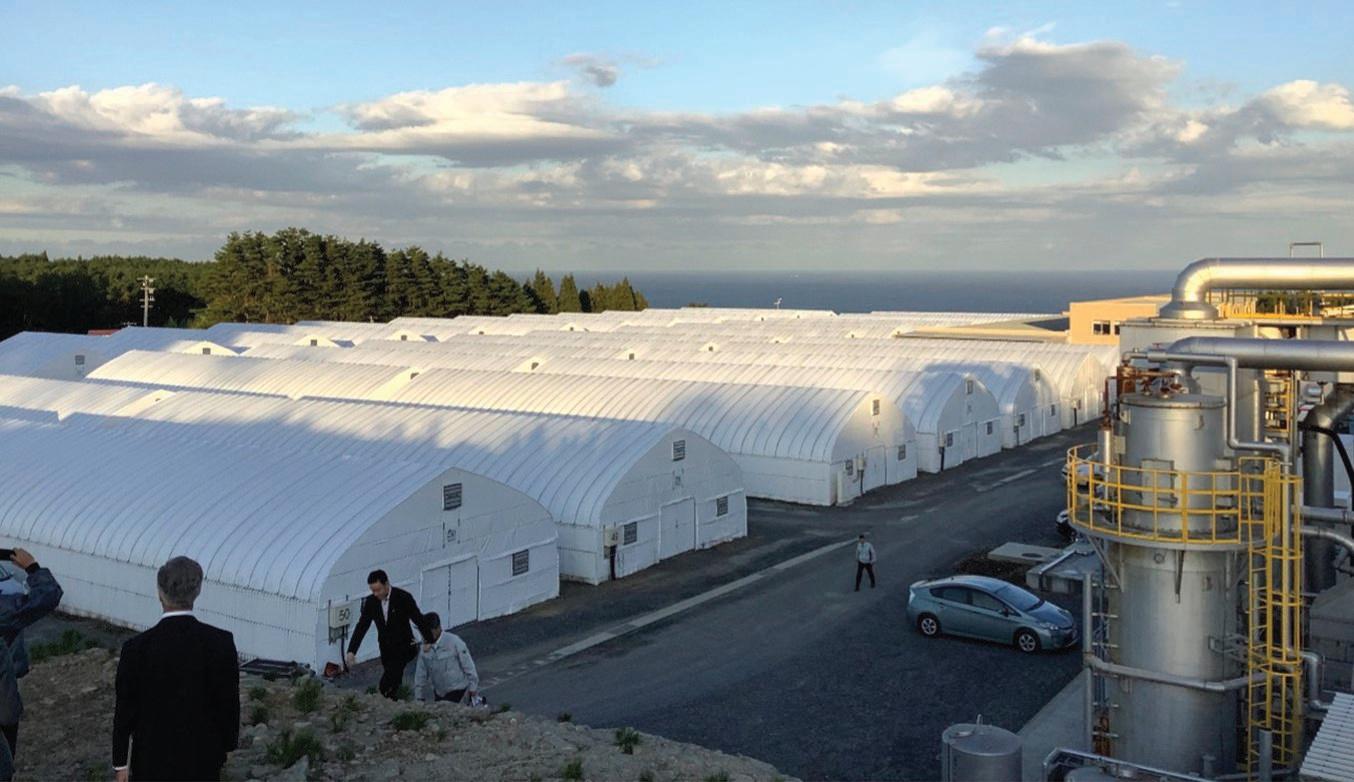
surplus heat to several biomass facilities in the local area. City officials hope that decarbonization will help entice those who have left Kuji to return. The city has signed up to the Renewable Energy 100 Declaration RE Action, a Japanese offshoot of the global RE100 initiative, aimed at getting municipalities and small and medium-sized enterprises to start working towards a carbon-neutral world. It’s also committed to reducing its net emissions to zero by 2050, in line with the goal of the Japanese government.
The establishment of a new municipal power company in Kuji, and its plans to create a virtuous economic cycle with clean local energy at the forefront, is perhaps something that other cities should take note of. A decade after Amachan put Kuji on the map, the city now has further reason to be proud.
10 | UNLOCK THE REAL JAPAN RENEWABLE ENERGY
KAZUYA KITAMURA
l Greenhouses for shiitake mushroom cultivation and a heat supply plant (right) operated by the Kuji Biomass Energy Corporation








What’s the Mitsui O.S.K. Lines Group’s vision for decarbonization?
“We announced our environmental policy more than 20 years ago and have been working to preserve the marine and global environment ever since. Addressing climate change is a pressing issue that can’t be avoided. In 2021, we took another step forward by formulating the MOL Group Environmental Vision 2.1, a more concrete roadmap which seeks to achieve net-zero emissions for the entire group by 2050. To achieve this we will reduce greenhouse gas (GHG) emissions intensity from transportation by 45 percent by 2035. We will also begin operating netzero-emissions vessels during the 2020s. These vessels are expected to be large commercial ships fueled by ammonia, and the first should be in operation by around 2027.”
What is your strategy for achieving netzero emissions by 2050?
“We have established five strategies to achieve our goals. First, we will switch to cleaner fuels that emit less GHGs. Second, we will introduce more energy-saving technologies. Third, we will increase the efficiency of our operations. Fourth, we will take an active role in participating in international rule-making and initiatives, and engage in diverse collaborative efforts to build a business model that enables net-zero emissions. Finally, we will expand our low-carbon and decarbonization businesses, such as those related to offshore wind power generation.”
What initiatives are you focusing on right now?
“We have started looking at clean fuels such as ammonia and hydrogen as alternatives to conventional heavy oil. We are working with shipbuilders, engine manufacturers, and engineering companies to build new vessels that run on these fuels. However, we can’t switch to clean fuels such as ammonia all at once, because we don’t yet have a supply system in place. As a transitional measure, we are starting with the conversion of heavy oil to liquefied natural gas, which is readily available and proven safe.”
How does the Wind Challenger work?
“It is a state-of-the-art sail system that uses wind power to assist propulsion. The height and angle of the sails are automatically controlled by computer to maximize the efficient use of wind
SEA change
Shipping company Mitsui O.S.K. Lines is aiming to achieve net-zero by 2050. Its vice-president

Toshiaki Tanaka tells Kiminori Hiromachi how it plans to reach its ambitious goal
power. Until now, large merchant ships have relied almost entirely on heavy oil for propulsion, but the addition of wind power makes it possible to reduce the amount of fuel used without altering operating speed.”
Wasn’t the world’s first electric tanker also launched this year?
“Yes, our EV tanker Asahi was completed in April 2022. It’s the world’s first EV tanker with fully electric propulsion. The Asahi is currently in service in Tokyo Bay as a fuel-supply vessel. Its lithium ion batteries can be recharged in six to ten hours and when fully charged, the ship
can travel approximately 200 kilometers. The batteries are charged with electricity certified to come from non-fossil fuel sources.”
What is the significance of working on decarbonization as a shipping company?
“The shipping industry is currently emitting enormous amounts of GHGs. It’s our mission to change this situation. If we don’t, we won’t be able to contribute to society or increase our value as a corporation. Our commitment to decarbonization is the embodiment of our corporate philosophy and is imperative for our sustainable growth as a company.”
12 | UNLOCK THE REAL JAPAN TRANSPORTATION SADATO ISHIZUKA
OUT OFthe woods
The Shibuya Marui department store is about to raise the bar for sustainability—by being completely demolished and replaced with an eco-friendly wooden version


structures including the redeveloped Reichstag building in Berlin and the Millennium Bridge in London, to design a new nine-story complex. It will offer close to 2,800 square meters of retail space, all dedicated to showcasing sustainable brands. Wood will be used for 60 percent of the building’s structure, with the construction process said to produce around 2,000 tons less carbon dioxide emissions than it would to develop an entirely steel structure.
Wood is an eco-friendly material that in tree form absorbs rather than produces carbon dioxide. Other sustainable materials will also be used which, along with the use of traditional Japanese building techniques, will reduce the complex’s environmental impact.
Upon its completion in 2026, the building will engage in sustainable practices for its day-to-day operations, including using electricity produced from renewable sources. The store itself will specialize in sustainable products provided by brands committed to protecting the environment and contributing to society in a positive manner. Marui Group hopes that by creating an exciting commercial facility such as this, they are providing a blueprint for a more sustainable retail experience. One of the previous projects completed by Foster + Partners, Bloomberg’s European headquarters in London, opened in 2017, received a high BREEAM (Building Research Establishment Environmental Assessment Method) rating, so expectations are for the new Shibuya Marui store to achieve similar.
To say that Shibuya Marui is getting a retro-style makeover would be putting it mildly. The department store, a mainstay in Shibuya since 1971 but arguably overshadowed these days by newer buildings, closed in August 2022 and is now set to be demolished and replaced with Japan’s first full-scale commercial building made of wood.
Demolishing and rebuilding a department store with a material that was usurped by concrete and steel in the popularity stakes more than a century ago may seem like an extreme measure, but Shibuya Marui’s dramatic change in appearance reflects consumers’ growing demand for sustainable products and practices. In the UK research from Deloitte published recently revealed that four out of five consumers have adopted
a more sustainable lifestyle since 2020, and a report by market research company GWI from 2021 stated that 44 percent of Japanese consumers would be prepared to spend more for an eco-friendly product.
Marui Group, the company behind Shibuya Marui, has enlisted the help of Foster + Partners, the British architecture firm known for numerous iconic
The architects have released some initial drawings, which show the structure as warm and inviting, with the bare wood acting as pillars, flooring, ceilings, counters, and display cases. It’s also shown to cover the entire façade of the complex, in stark contrast to the steel and glass-clad buildings surrounding it.
If consumers are to put their money where their mouths are and start spending on sustainable products, then where better than an entire store that embraces such environmentally conscious goals? The hope is that the store’s radically different look will also be a source of intrigue, and could incentivize in-person shopping when competition from online platforms continues to grow in intensity. If Marui Group gets this right, then a whole new shopping world could be just around the corner.
ARCHITECTURE
FOSTER + PARTNERS
A
SPECIAL MAGAZINE BY Nikkei Asia | 13
l An artist’s impression of the new look Shibuya Marui
l The new look Shibuya Marui will be completed in 2026
Making waves
How Mitsui O.S.K. Lines plans to revolutionize shipping by ushering in a carbon-neutral age


There’s change in the air. According to the International Maritime Organization (IMO), international shipping accounts for 2.2 percent of all annual global greenhouse gas emissions. In 2018, the IMO committed to halving those emissions by 2050 compared to 2008 levels and to help achieve this ambitious objective, shipping companies across the globe have been busy developing greener alternatives to diesel-powered vessels. One of the most promising inventions in the field is the Wind Challenger, a new breed of sail designed by Japanese maritime shipping company Mitsui O.S.K. Lines (MOL). Here’s how MOL plans to harness the power of the wind.
Back to the future
Though sailing ships once ruled the oceans, they gave way to stronger and more practical steam-powered vessels in the 19th century, which were in turn replaced by diesel ships in the 20th century. But with the climate crisis raging, the days of vessels running on fossil fuels may be numbered. Now, a combination of ageold techniques with new technologies could well see sail-powered cargo vessels
making a striking comeback. MOL is one of several innovative companies that are working towards greener shipping by implementing wind-assisted propulsion systems in their fleets.
Sail of the century
MOL’s trump card is the Wind Challenger, a giant hard sail that can be installed on the deck of existing cargo ships. The sail adds wind power directly to the ship’s propulsion force, reducing fuel consumption without slowing the craft’s progress. The Wind Challenger is
made up of a steel sail base and three vertically moving panels made from GFRP, or glass fiber reinforced plastic. Thanks to this sturdy yet lightweight material, MOL has been able to create a large sail capable of generating maximum wind-assisted propulsive power without affecting the ship’s balance and the amount of freight that the vessel can carry.
Plain sailing
As any wannabe sailor will know, maneuvering even an ordinary sailboat requires extensive knowledge and
experience, since the sails’ direction and tension must be adjusted according to the wind. The Wind Challenger, on the other hand, is controlled automatically by a computer on the vessel’s bridge which can easily be operated by any crew member.
The hard sail is equipped with sensors that detect the strength and direction of the wind, automatically extending the sail when conditions are calmer and lowering it when the wind blows too hard. The Wind Challenger’s four 15-meter-wide panels can extend from 23 meters up to a height of 53 meters and rotate automatically based on the wind’s direction. Even when there’s a crosswind, the Wind Challenger is able to push the vessel forward.
Getting back on an even keel
The Wind Challenger’s aim is to help bring shipping’s
PARTNER CONTENT
14 | UNLOCK THE REAL JAPAN
greenhouse gas emissions down. To calculate the benefits of the propulsion force generated by the Wind Challenger compared to traditional cargo ships, MOL has conducted a series of computational fluid dynamics modeling and wind tunnel experiments.
In a head-to-head simulation of an unassisted 100,000-deadweight-ton bulk carrier (dwt refers to the amount of weight a ship can carry), with one fitted with Wind Challenger the results were encouraging. The simulations showed a five percent annual reduction in greenhouse gas emissions on the Japan-Australia route for vessels with Wind Challenger installed and an eight percent reduction on the route between Japan and the west coast of North America.
l The Shofu Maru is the first vessel to be equipped with an active Wind Challenger system
Setting sail
The first active Wind Challenger system has been installed on the Shofu Maru, a 100,000-dwt coal carrier that is scheduled to set sail for a two-week journey on the Japan-Australia route in October 2022. While the Shofu Maru only has one hard sail attached to its bow, several Wind

Challengers can be installed simultaneously on the decks of bulk carriers, tankers, and liquefied natural gas carriers to increase propulsion force and further reduce emissions. MOL hopes that when the shipping world sees the benefits of harnessing wind power— cutting costs and helping to save the planet—they’ll be all aboard.
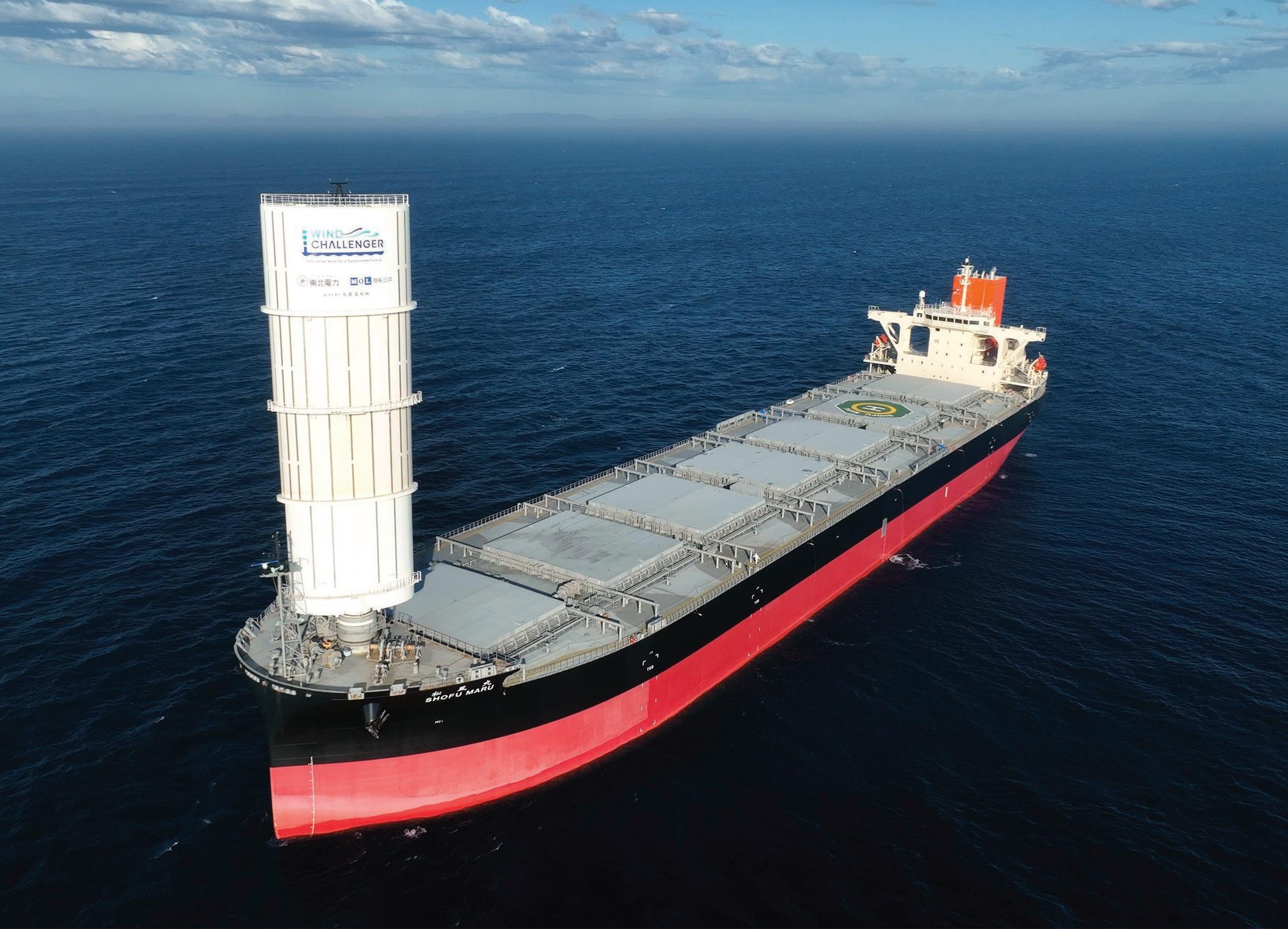
PARTNER CONTENT | 15
The Wind Challenger’s aim is to help bring shipping’s greenhouse gas emissions down
ALL IMAGES © MITSUI O.S.K. LINES
FREAK OF nature
Why is clothing chain Freak’s Store expanding into renewable energy and popcorn farming?
Tabea Greuner finds out
There are many things one may associate with Ibaraki-born clothing retailer Freak’s Store: on-trend selections of mainly American fashion, a focus on community, sustainability incorporated into every aspect of their business. Yet despite its reputation for putting an emphasis on ethics, not many people foresaw the fashion retailer entering the world of renewable energy production.
But following Japan’s commitment to net-zero carbon emissions by 2050, the fashion house, which has 47 outlets across Japan, has indeed entered the energy market. In collaboration with green power company Minna-Denryoku, the apparel store launched Freak’s Denki (“Freak’s Electricity”) in June this year to increase renewable energy options for its customers and contribute to the transition to a more
sustainable society. All electricity sold through Freak’s Denki is generated by a solar power station in the city of Ueda, Nagano Prefecture.

The relationship between MinnaDenryoku and Freak’s Store isn’t completely out of the leftfield. The clothing chain’s Shibuya outlet has been purchasing electricity from the supplier’s renewable energy sources for a while and a proportion of the store’s monthly electricity bill goes toward supporting designated power stations in areas affected by the 2011 Great East Japan Earthquake. But Freak’s Denki has raised the stakes by not only enabling individual consumers to switch to green energy but also support local initiatives—mainly in Nagano Prefecture—while they do so.
The Nagano city branch is one of Freak’s Store’s key outlets and has
long been known for its community outreach activities. Once a month, the shop collaborates with the city’s Seed and Soil Market to sell fresh local produce. Nagano’s population decline has led to more and more farmland being abandoned.

Picking corn
To help find a use for this land, organizers of the Seed and Soil Market established the nonprofit organization Shinano Soil, which is repurposing abandoned farmland for corn cultivation and the production of organic popcorn. The type of corn crop grown by Shinano Soil has a comparatively short harvesting cycle and is relatively resistant to damage caused by wildlife, which is rising as the human population decreases. Freak’s Store, building on its longstanding relationship with Seed and Soil Market, supports the Shinano Soil project through packaging, promotion, and sales initiatives, and Freak’s Denki donates ¥100 of each customer’s monthly electricity bill to corn cultivation and popcorn production.
But why corn? Most of the popcorn sold in convenience stores and movie theaters in Japan is imported, and the people behind Shinano Soil hope that domestic production of the snack could help create jobs across Nagano Prefecture. They’re also aiming for popcorn to become a local specialty one day.
Freak’s Denki subscribers are able to participate in this unique community through a variety of events—think cornharvesting experiences, assisting in the process of popcorn development, and attending webinars on environmental issues. By keeping everything from power production to popcorn-growing participatory and extremely local, Freak’s Store is kickstarting a new and empowering form of sustainability action. And its trousers still look great to boot.
l Organic popcorn grown at the Shinano Soil fields for sale in Freak’s Store, Nagano
16 | UNLOCK THE REAL JAPAN SUSTAINABLE BUSINESS
IMAGES COURTESY OF DAYTONA INTERNATIONAL






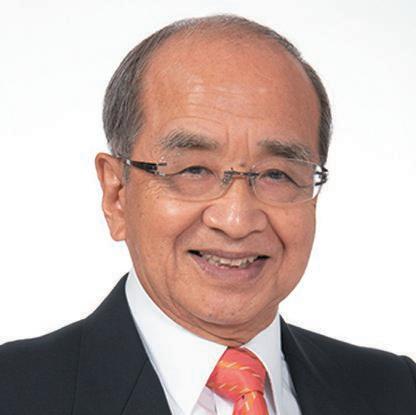






Atwo-hour journey from Tokyo by train through a mountainous landscape takes us from Tokyo to Minamiuonuma in Niigata Prefecture, one of Japan’s leading ricegrowing regions. The Koshihikari cultivar produced here is often cited as Japan’s tastiest rice and its production certainly makes for beautiful views. Lush paddy fields line the Uono River, which flows through the plains, and clusters of golden rice ears are swaying in the cool latesummer breeze. Overlooking the scenery is the hilltop Satoyama Jujo The House, a modern ryokan inn set inside a traditional Japanese country home.
“It’ll only be a little longer until all the rice ears in the paddies change color and the entire area turns golden,” says Toru Iwasa proudly. “This is a snowy landscape in winter, in spring the paddies look like reflecting mirrors. Here you have nature changing throughout the seasons, always right in front of you. Isn’t it precious?”
Custom made
Iwasa is the CEO of Jiyujin, an ambitious sustainable tourism company which publishes a food- and travel-themed publication (also called Jiyujin) and runs several beautiful hotels across the country. Satoyama Jujo The House is an extension of the company’s first property in Minamiuonuma, an area very special to Iwasa. Having found success as a magazine editor in Tokyo, Iwasa set out in search of “true fulfillment”—a journey that brought him to Minamiuonuma in 2004. Here he discovered the joys of the traditional Japanese lifestyle and culinary culture. Determined to share what he’d found with others, he opened the Satoyama Jujo hot-spring inn in the area in 2014, adding “The House” in 2021.
Satoyama Jujo revives a 150-yearold building, fully renovating it while retaining as much of its original charm as possible. The meals prepared in its kitchen don’t use imported ingredients, being made instead from the finest Koshihikari rice and locally grown vegetables and wild plants. The rotenburo open-air baths offer guests views of the picturesque fields which provide the delicious fare on their plates.
Incorporating what its founder considers Minamiuonuma’s “unique value,” Satoyama Jujo quickly found a receptive audience and now enjoys a
A CLEAN break
Toru Iwasa, creative director and CEO of sustainable tourism company Jiyujin talks to Risa Shoji about how the preservation of local environments, food and traditions can encourage visitors to choose a greener and fairer holiday
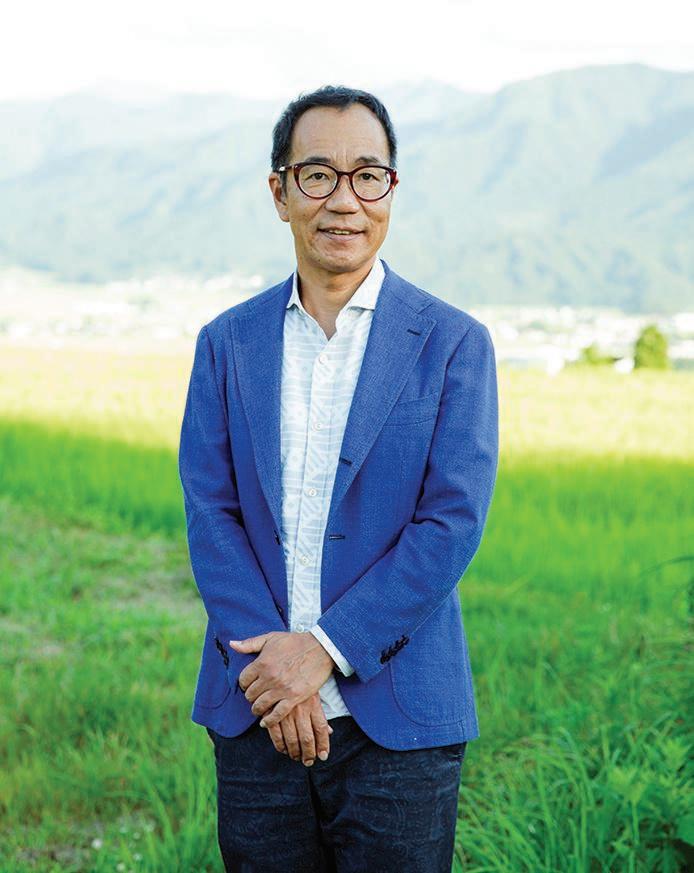
up to three meters. But it’s precisely because of this harsh environment that a unique food culture, one that makes full use of fermentation and preservation techniques, has developed here. The fine pillars, beams, and timber framings of the old houses in this area are beautiful yet functional—a design unique to snowy regions, created to withstand the weight of the snow. History and the traditional culture fostered over centuries have value that can’t be measured in numbers. I want my inn to express and convey this value.”
constant stream of guests year round. Iwasa’s approach, which combines economic viability with protecting local life and the environment, is a hallmark of sustainable tourism—yet he was practising it long before the term became fashionable in Japan. When asked how he was able to pioneer and utilize the concept in building Satoyama Jujo, Iwasa ponders the question for a moment before choosing his words carefully. “It’s hard to point at any one thing, but maybe it has to do with the way I make sure to respect each place’s circumstances and history,” he says. “For example, Minamiuonuma gets some of the heaviest snowfall in Japan—
Careful study of the history and culture of a region has led to Iwasa discovering unique traditions and practices that have been handed down from generation to generation. But Iwasa emphasizes that simply protecting and passing on these “treasures” will not lead to business success. “To turn local treasures into resources and establish sustainable tourism, it’s essential to look at convenience and comfort,” he says thoughtfully. “No matter how often you tell people that ‘these vegetables can only be picked here,’ if the food doesn’t taste good, guests won’t be happy. If an old house remains in its original state, it’s likely to be cold and inconvenient, making it impossible to provide a great accommodation experience. It’s important to be creative and produce something new based on a deep understanding of history and culture.”
18 | UNLOCK THE REAL JAPAN SUSTAINABLE TOURISM
KEISUKE TANIGAWA
l Toru Iwasa, CEO of Jiyujin
Spurred on by his success in Minamiuonuma, Iwasa is now involved in regional revitalization projects across Japan, all focused on the “rediscovery of value.” His innovative and creative restoration methods are on full display at the acclaimed Koo Otsu Hyakucho in Otsu, Shiga Prefecture, which is the first hotel in Japan to occupy a restored machiya townhouse in a traditional shopping arcade, and at Hakone Honbako, a former corporate recreation facility turned literary hotel in Hakone, south of Tokyo.

Saving grace
The House is the first facility in a series of new projects Iwasa is planning in the Minamiuonuma area. “There are houses here that are over 100 years old,” he says, “but many of them are being demolished one after another because they are too cold or inconvenient to use. In order to preserve these precious structures as important local resources for future generations, we plan to renovate them one by one and turn them into inns.”
Ever since launching Jiyujin magazine, Iwasa has concentrated on highlighting the value of rural areas and on conveying what makes them great. His consistent approach has influenced many others in the tourism industry, which is looking forward to a post-pandemic rebound in international travel to Japan. But what can the country do to stand out in the global market for sustainable tourism?
“Food obviously has the greatest potential [to attract tourists], and every region has its own food culture,” he says, expanding on rice as an example. “Rice is not only our staple grain; it was traditionally what the economy revolved around. Taxes were paid in rice, and the
value of land was expressed in koku—the amount of rice needed to feed one person for a year. Rice bran, the byproduct of polishing rice, has contributed to our culture of fermented foods, such as nukazuke (pickles made in brine and fermented rice bran). There are countless other foods made from rice, such as rice vinegar, sake, mochi (sticky rice cakes) and senbei (rice crackers). Still, most Japanese people aren’t consciously aware of the history and culture associated with rice. Japanese society developed alongside rice cultivation, but rice is so familiar to us that we don’t realize its value.”

Not that food is the only way to a budding sustainable tourist’s heart.
“Of course, a region that’s strong in forestry could focus on housing, or a place that’s known for its textiles or dyed goods could consider new initiatives in the clothing sector,” Iwasa continues before stressing that it all comes back to sustainability. “The traditions handed down from generation to generation locally must be preserved for future generations,” he says. “I believe that over time, tourism can cultivate local pride and lead to the sustainable development of a region. What’s key is that each and every person involved in sustainable tourism locally shares that perspective and plays their part.”
l
Satoyama Jujo The House
The traditions handed down from generation to generation locally must be preserved
A SPECIAL MAGAZINE BY Nikkei Asia | 19
KEISUKE TANIGAWA
Freshly cooked Koshihikari rice
IT’S ONLY natural
Farmer, chef and sake brewer Yotaro Sasaki tells Akiko Toya how he turned his fields green by going organic

Yotaro Sasaki is the fourthgeneration owner of Minshuku Tono, the oldest surviving traditional farmhouse in Tono, Iwate Prefecture, which his family have been running as an inn for over a century. When Sasaki took over the family business he set about transforming it, focusing on the brewing of doburoku (unfiltered sake) with rice grown on his land using completely organic techniques. Now 41 and having perfected both his unique brew and natural farming methods, Sasaki has branched out launching a restaurant, hotel and fermented foods business—all underpinned by respect

for the Earth. Here he shares the recipe of his chemical-free success.
Waste not want not
“I’ve been growing rice for 21 years and I can now make doburoku, vinegar and various other drinks from rice in a way that doesn’t produce waste. For example, I use the rice bran and other residue that’s released when pressing the rice to make non-alcoholic drinks, and sake lees [another by-product of the brewing process] to make vinegar. I’m also working with the Tokyobased chocolate maker Minimal to develop chocolate that contains rice bran.”
The little things matter
“When you’re producing food, you start to take notice of microorganisms and other tiny natural phenomena. I try to give these a voice by communicating the importance of the soil in food production. I hope to restore the health of the soil by reviving its natural cycle. As soon as you do some research, you’ll understand why [chemical] fertilizer and pesticides are bad. Fertilizer doesn’t decompose and remains in the soil, which leads to water pollution, while pesticides kill microbes. That cycle results in sandy farmland.”
It’s not too late to restore balance
“When you eliminate pesticides from a rice field, you notice how the surrounding environment changes. Since I’ve stopped using [chemicals], insects and reptiles have come to my paddies. Those animals then attract large wild birds. I often hear from rice farmers how sparrows cause damage, but we’re actually seeing a positive impact thanks to the larger birds. The birds’ droppings contain various seeds, which have resulted in mint and berries growing nearby. This cycle also results in a rich forest. We see lots of wild animals, and nature is coming back to life. I think what I’m doing on my paddies is my greatest contribution to the local community.”
There’s more to life than survival of the fittest
“Survival of the fittest is a fundamental feature of nature but we can’t deny that humans, at the top of the food chain, are putting pressure on the planet. I’m not anti-science, I drive a car and use electricity like other people. The problem is that we’ve gone too far, and it’s really important to think of ways to give back to nature. My contribution is through rice farming and soil cultivation, which I think are very natural things to do.”
20 | UNLOCK THE REAL JAPAN GASTRONOMY
YOTARO SASAKI
l Yotaro Sasaki’s farm in Tono, Iwate Prefecture, is completely organic
I hope to restore the health of the soil by reviving its natural cycle





ETIQUETTE GUIDE: TRAVEL
After almost three years of Covid-enforced restrictions, Japan is finally opening up again to travelers. As with most things, the country has its own set of customs for polite travel by plane, train or automobile. Here’s how to ensure smooth travels wherever you go Guide: Karolina Höglind and Marcus Webb
By taxi
Do: Wait for the door to open
Riding a taxi, like many other everyday activities in Japan, is bound by social rules. After flagging down a cab, you should not open the car door yourself. Drivers have buttons that open the back door automatically (the door also closes automatically when you exit). Always sit in the back; the front passenger seat is only used when the back seats are filled.
Don’t: Tip the driver
If you don’t tip in New York, a taxi driver will chase you down the street asking what the problem is. In Japan they’ll chase you if you do, thinking you’ve forgotten your change: the fare along with pride in doing a good job is reward enough.
By metro
Do: Board the right carriage
A number of subways and local trains in Japan have women-only carriages— often only in effect for the rush hour. These are usually marked by pinkpainted markers on the platform. The choice of color might not be very politically correct, but it will match the shade male passengers turn if they board the wrong car.
Don’t: Take a phone call
You’re on the train and your phone rings. Anywhere else, the worst that
might happen is that you go into a tunnel and your conversation cuts off. In Japan, however, submitting innocent bystanders to your cell phone chitchat is deeply frowned upon. Instead, ignore the impulse to answer and send a quick text to say you’re on the train. And whatever you do, be sure to put your phone on silent (‘manner mode’) before boarding so your novelty ringtone doesn’t shatter the sacrosanct peace and quiet of rush hour.
By shinkansen
Do: Bring your meal on board
While eating on local trains is very much frowned upon, when it comes to the shinkansen, or bullet train, it’s positively
encouraged. Ekiben—from the words eki (railway station) and bento (boxed lunch)—are boxes filled with local specialties designed to be eaten on the go. You can pick one up at most shinkansen stations.
Don’t: Forget to book your luggage on board
If you’re the kind of person that likes to pack the kitchen sink, then you’ll need to think ahead. Since 2020 those traveling on the shinkansen with ‘oversized’ luggage (with a total length, height and depth measurement of more than 160cm) have to reserve a special seat, which includes storage space for their baggage behind the seat.
By plane
Do: Keep your mask on
While most flights in Europe and the US have done away with mask mandates, if you’re traveling to Japan you’ll need to keep things covered. All passengers, regardless of vaccination status, need to have a mask that covers their nose and mouth at the airport and in the cabin. Although you are allowed to remove your mask while eating or drinking.
Don’t: Forget to look back
One of the most touching aspects of flying with a Japanese airline is that if you look to the terminal as the plane taxis to the runway, you’ll see all the ground staff bowing back at you— wishing you a safe journey in the skies.
ANY OTHER BUSINESS
22 | UNLOCK THE REAL JAPAN ILLUSTRATION JAMES
LADBURY



































































